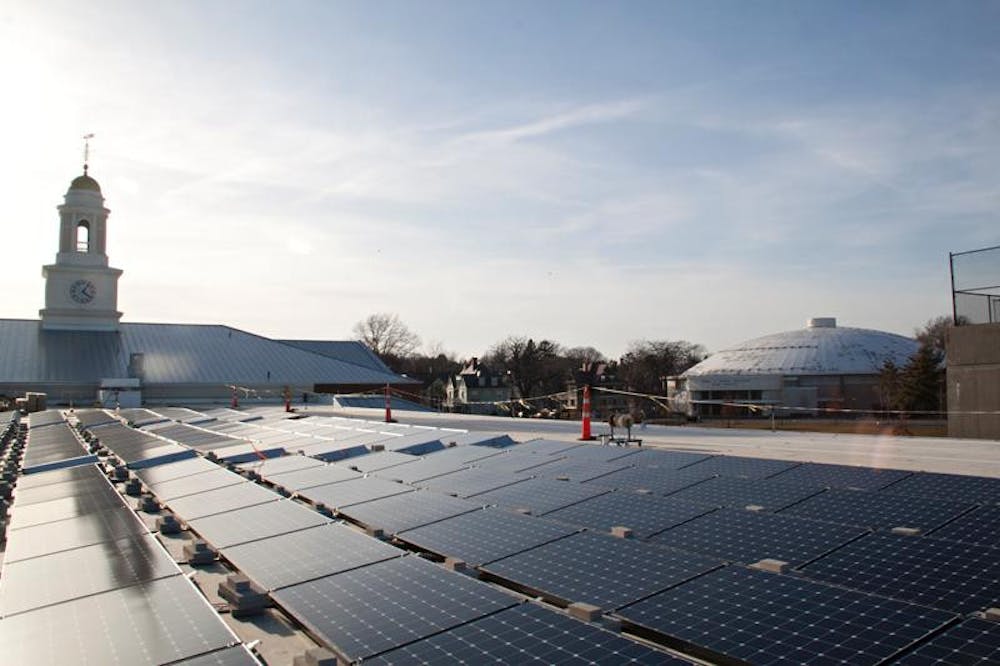Brown is now home to the largest installation of hybrid solar-thermal panels in the country.
The 168 panels, which cover half the roof of the Katherine Moran Coleman Aquatics Center, will provide around 10 percent of the building's energy needs - equivalent to the number of panels it would take to power 10 homes, said Kai Morrell '11, energy and environmental outreach coordinator for the Department of Facilities Management.
The $800,000 panels combine photovoltaic technology with solar-thermal technology, meaning they both heat water and create electricity. That combination was a perfect fit for the new aquatics center, which requires large amounts of hot water to maintain its Olympic-sized swimming pool and showers, said Chris Powell, director of sustainable energy and environmental initiatives at Facilities Management. "It was a bit of a no-brainer," he said.
The Energy and Environmental Advisory Committee, which Powell chairs, had originally planned a solar installation for the roof of the GeoChem Building. That project fell through because of GeoChem's incompatible roof design, said Kurt Teichert, lecturer in environmental studies and manager of environmental stewardship initiatives."
Robert A.M. Stern Architects, the firm that designed the aquatics center, needed to "go back to the drawing board and incorporate (the panels) into their design," Powell said.
"It's outstanding that we're doing a solar-thermal system, because it's too often overlooked," Teichert said. The efficiency of a solar-thermal system is superior to that of a system that uses only photovoltaic or only thermal technology, he said. "It's just that all the incentives and buy-downs tend to be oriented towards photovoltaic, and not solar-thermal."
The hybrid panels at the aquatics center "barely eke out a return on investment," with a payback time of about 15-20 years, Powell said.
"We realized that renewables weren't the best economic choices," but their educational value makes them worth the cost, he said.
The panels have already been used as an educational tool in two classes. Students in ENVS 0410: "Environmental Stewardship" viewed the installation in progress from the roof of the Olney-Margolies Athletic Center with a representative from SunDrum, the company that designed the hybrid technology.
"I think students were surprised by the energy intensity of that building," Morrell said. "It takes a ton of energy to heat a pool and dehumidify that space and run all the showers and locker rooms. The fact that we have that many panels, and it only covers 10 percent of the building's energy - I think that really blew students' minds."
Three additional panels were donated to the School of Engineering, where they are being used in ENGN 1930U: "Renewable Energy Technologies."
Ka Ling Wu '14, a student in the class, was impressed by how much voltage could be created from one panel. "I had never heard of the hybrid (technology) before," she said. "Whenever I'm talking to my friends, I feel like I'm a cool kid, because I get to work with these panels. People are impressed."
The installation is part of a larger effort to reduce the University's greenhouse gas emissions. New buildings must meet Brown's 2008 Greenhouse Gas Goals, which require buildings to be designed to meet a minimum Leadership in Energy and Environmental Design rating of Silver and consume 25 to 50 percent less energy than the standard required by state code. Often, new buildings achieve a LEED Gold rating, partially due to the additional 25 to 50 percent reduction requirement, Teichert said.
Brown decided to use LEED certification as a measure of sustainability in part "as a tool to explain to the larger community what our commitment is," he said. "Saying LEED Silver resonates more clearly than '25 to 50 percent better than the prevailing code,'" he said.
The aquatics center has been designed to LEED Silver standards, though it will not receive the certification until it has demonstrated certain performance standards, a process that can sometimes take years.





